Contents
- 1. TRX7431 User Manual
- 2. Teklogix 9150 Wireless Gateway User Manual
- 3. Teklogix 9150 Wireless Gateway User Manual Declaration of Conformity
- 4. Teklogix 9150 Wireless Gateway User Manual Cautions to Users
- 5. Teklogix 9150 Wireless Gateway User Manual Teklogix Offices
- 6. Teklogix 9150 Wireless Gateway User Manual Table of Contents
- 7. Teklogix 9150 Wireless Gateway User Manual Chapter 1 Introduction
- 8. Teklogix 9150 Wireless Gateway User Manual Chapter 2 Installation Requirements
- 9. Teklogix 9150 Wireless Gateway User Manual Chapter 3 9150 Main Configuration
- 10. Teklogix 9150 Wireless Gateway User Manual Chapter 4 Base Station Configuration
- 11. Teklogix 9150 Wireless Gateway User Manual Chapter 5 Mini Controller Configurati
- 12. Teklogix 9150 Wireless Gateway User Manual Chapter 6 Access Point Configuration
- 13. Teklogix 9150 Wireless Gateway User Manual Chapter 7 Specifications
- 14. Teklogix 9150 Wireless Gateway User Manual Appendix A
- 15. Teklogix 9150 Wireless Gateway User Manual Appendix B
- 16. Teklogix 9150 Wireless Gateway User Manual Index
- 17. Teklogix 9150 Wireless Gateway User Manual Appendix A
- 18. 7035 8255 8260 User Manual
- 19. 9150 User Manual
- 20. response to FCC correspondence 15472
Teklogix 9150 Wireless Gateway User Manual Chapter 6 Access Point Configuration

Teklogix 9150 Wireless Gateway User Manual 123
ACCESS POINT CONFIGURATION 6
6.1 Overview..............................125
6.2 Interfaces..............................126
6.2.1 IEEE 802.11 (Frequency Hopping Radio Parameters) . . 126
6.2.2 IEEE 802.11 (Direct Sequence Radio Parameters) . . . . 128
6.3 MAC Bridge Parameters......................129
6.3.1 General Configuration . . . . . . . . . . . . . . . . . 131
6.3.2 Address Filters: MAC Address . . . . . . . . . . . . 132
6.3.3 Protocol Filters.....................133
6.3.3.1 Ethernet II Filters . . . . . . . . . . . . . . . . 136
6.3.3.2 LLC Filters ...................137
6.3.3.3 SNAP Filters...................138
6.3.3.4 Storm Detection.................139
6.4 Mobility Configuration ......................140
6.4.1 IAPP Parameters....................142

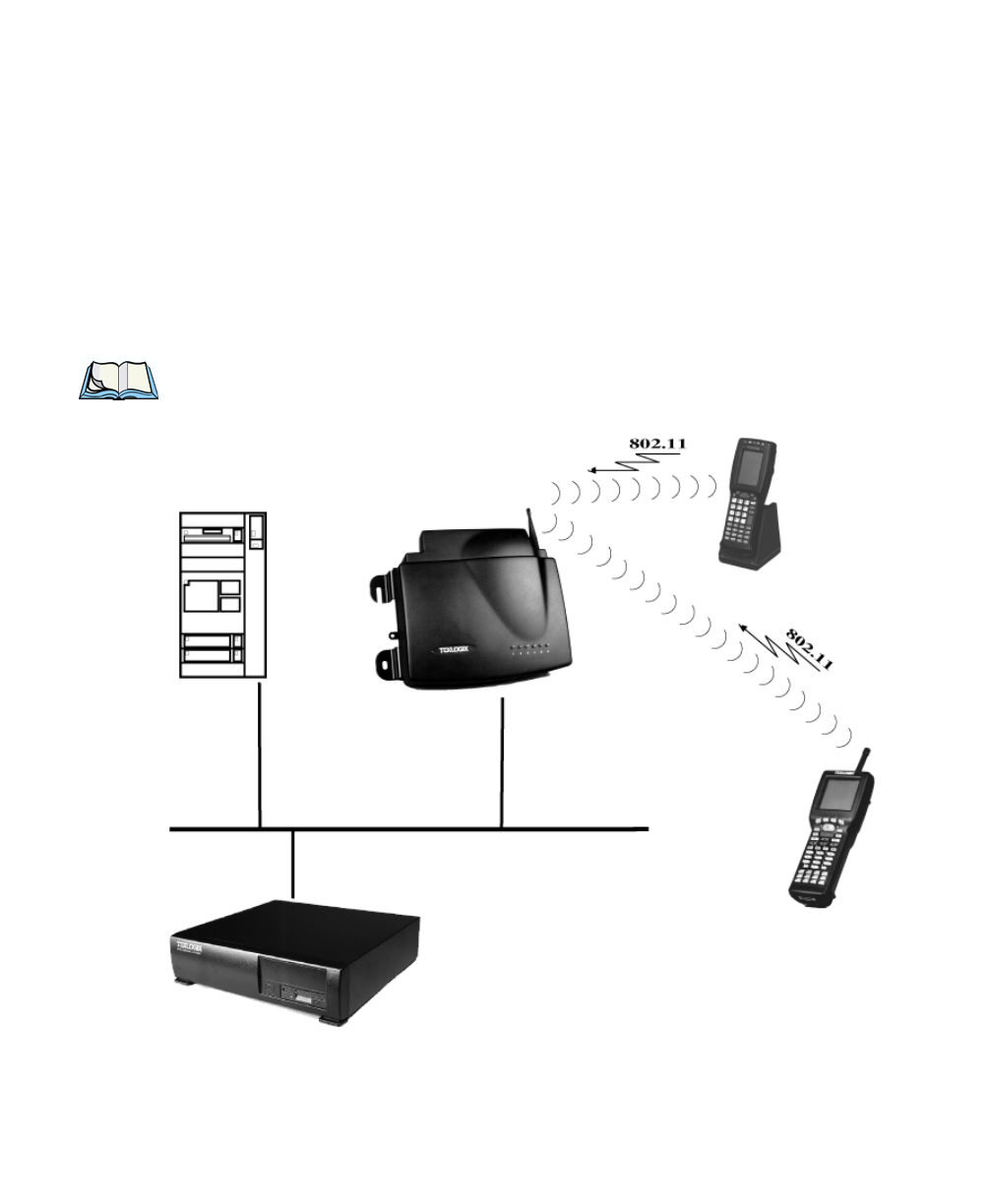
Teklogix 9150 Wireless Gateway User Manual 125
Chapter 6: Access Point Configuration
Overview
6.1 Overview
The 9150 can operate as an access point device between IEEE 802.11 wireless
and wired networks. Using IEEE 802.11 protocol, the 9150 provides a transparent
bridge between Teklogix or client terminals and a network controller or host. For an
overview of IEEE 802.11, please refer to “IEEE 802.11 Protocol” on page 10.
For operation as an access point, the parameters in the following pages must be
set appropriately.
Note: The 9150 main parameters should first be set up as described in Chapter
3: “9150 Main Configuration”.
Figure 6.1 9150 Access Point Configuration
ETHERNET
TCP/IP
9150
Wireless Gateway
RF Terminal
7040
Network Controller
RF Terminal
7035
9400
Hand-Held
Hand-Held
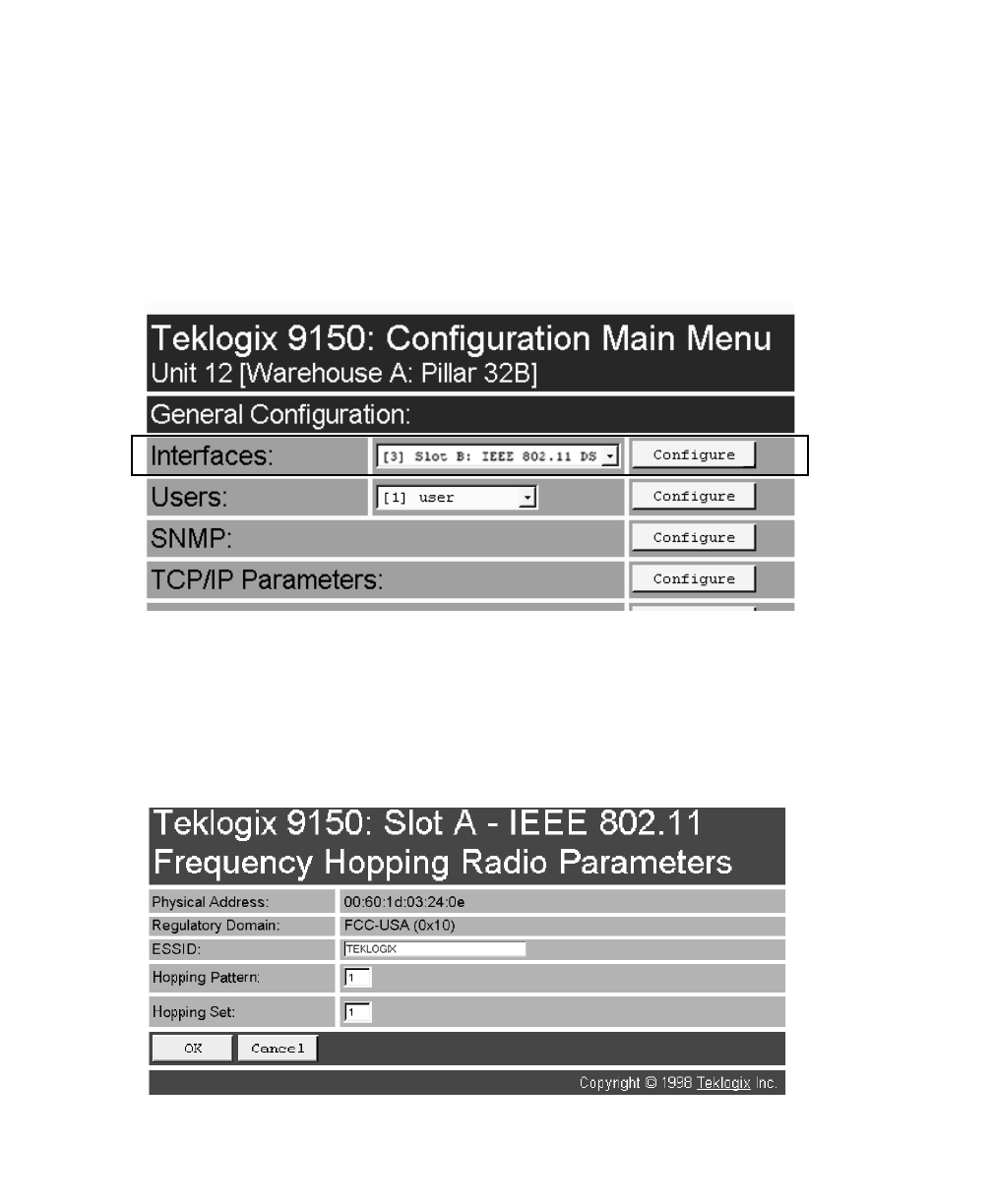
Chapter 6: Access Point Configuration
Interfaces
126 Teklogix 9150 Wireless Gateway User Manual
6.2 Interfaces
The pull-down menu shown for the Interfaces option indicates which interfaces have
been detected in use by the 9150, including one of two 802.11 PCMCIA radios:
•IEEE 802.11 FH: Proxim RangeLAN802 IEEE 802.11 FHSS 2.4 GHz.
•IEEE 802.11 DS: Lucent WaveLAN IEEE 802.11 DSSS 2.4 GHz.
Selecting a radio type from the drop-down list and entering “Configure” will open
the radio parameters page for that radio.
6.2.1 IEEE 802.11 (Frequency Hopping Radio Parameters)
When the Proxim RangeLAN802 IEEE 802.11 FHSS 2.4 GHz PCMCIA card is
installed in the 9150, the following radio parameters page is opened:

Teklogix 9150 Wireless Gateway User Manual 127
Chapter 6: Access Point Configuration
IEEE 802.11 (Frequency Hopping Radio Parameters)
Physical Address
This parameter shows the hardware address (MAC address) of the radio card.
A globally unique MAC address is assigned to each card by the card manufacturer.
The value cannot be changed.
Regulatory Domain
The regulatory domain value identifies the regulatory body’s country code for the
RF regulations with which the radio complies. For the USA, the regulatory body is
the FCC, for Canada it's Industry Canada, and for Europe it's ETSI. The hex value in
brackets beside the name is the code (as specified in the IEEE 802.11 standard) for
that domain. The country codes that are decoded into a name are listed below. For
other country codes the name portion will be replaced with "Unknown".
ESSID
This is the Extended Service Set Identifier parameter. The ESSID is an
alphanumeric character string of up to 32 characters and is case-sensitive. If your
network includes devices that use the DOS ODI Driver, select alphabetical charac-
ters in uppercase only to allow the DOS ODI devices to connect to the network as
well. The ESSID should be the same for all devices in a system.
Hopping Pattern
The combined settings for the Hopping Pattern and Hopping Set parameters deter-
mine the operating channel for a radio using frequency hopping. Please refer to your
network administrator for details.
Hopping Set
The combined settings for the Hopping Set and Hopping Pattern parameters deter-
mine the operating channel for a radio using frequency hopping. Please refer to your
system administrator for details.
Regulatory Body Domain Code Country
FCC-USA 0x10 USA (for DS radios this is also the code used
for Canada)
Industry Canada 0x20 Canada (currently only for FH radios, this may
change in the future)
ETSI-Europe 0x30 Most of Europe
Spain 0x31 Spain
France 0x32 France
MKK-Japan 0x40 Japan
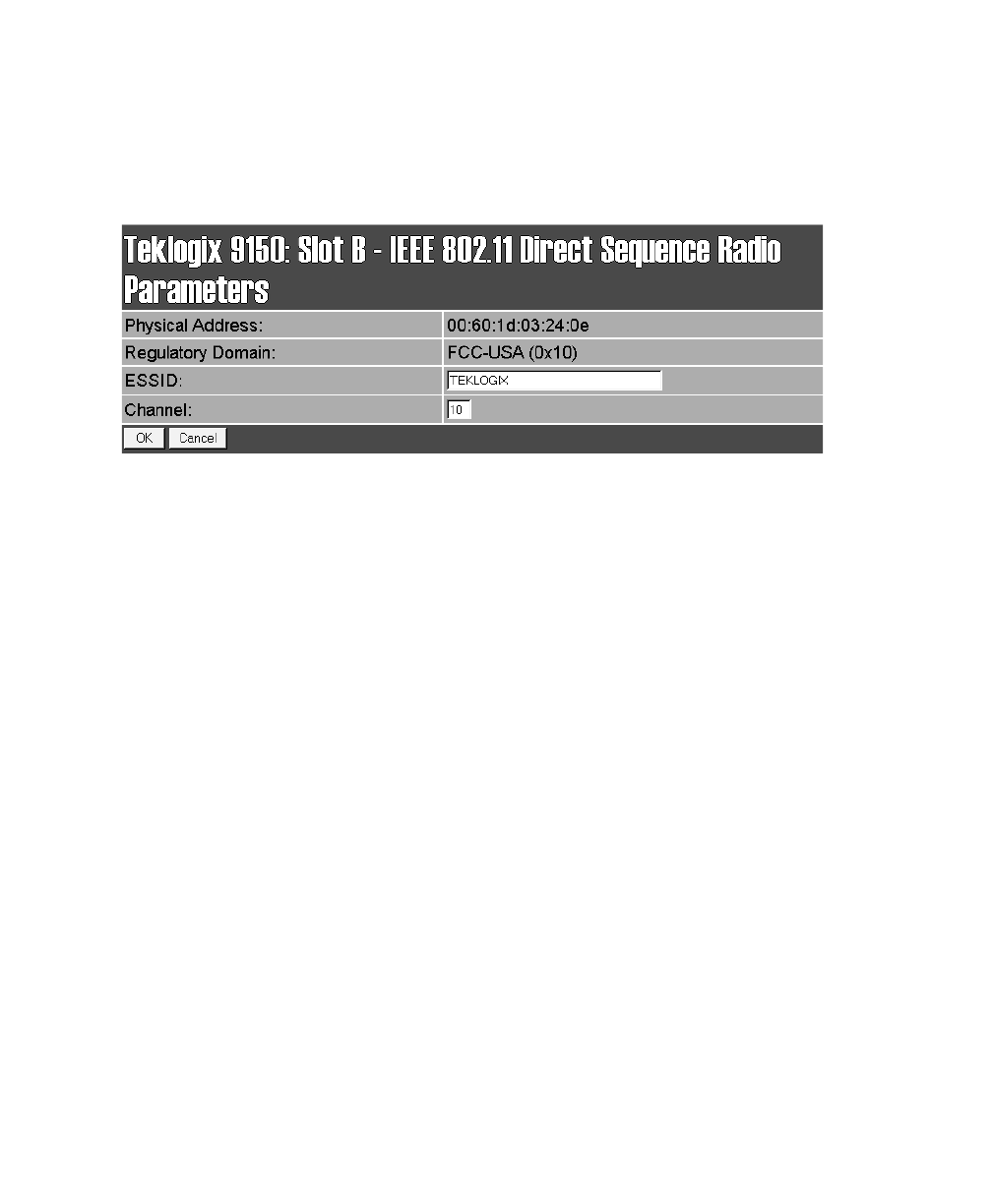
Chapter 6: Access Point Configuration
IEEE 802.11 (Direct Sequence Radio Parameters)
128 Teklogix 9150 Wireless Gateway User Manual
6.2.2 IEEE 802.11 (Direct Sequence Radio Parameters)
When the Lucent WaveLAN IEEE 802.11 DSSS 2.4 GHz PCMCIA card is installed
in the 9150, the following radio parameters page is opened:
Physical Address
This parameter shows the hardware address (MAC address) of the radio card.
A globally unique MAC address is assigned to each card by the card manufacturer.
The value cannot be changed.
Regulatory Domain
The regulatory domain value identifies the regulatory body’s country code for the
RF regulations with which the radio complies. For the USA, the regulatory body is
the FCC, for Canada it's Industry Canada, and for Europe it's ETSI. The hex value in
brackets beside the name is the code (as specified in the IEEE 802.11 standard) for
that domain. The country codes that are decoded into a name are listed on page 127.
For other country codes the name portion will be replaced with "Unknown".
ESSID
This is the Extended Service Set Identifier parameter. The ESSID is an
alphanumeric character string of up to 32 characters and is case-sensitive. If your
network includes devices that use the DOS ODI Driver, select alphabetical charac-
ters in uppercase only to allow the DOS ODI devices to connect to the network as
well. The ESSID should be the same for all devices in a system.
Channel
This parameter sets the operating channel for this radio, as determined by the system
administrator. For a listing of the allowable channels for each country, please see
“PC Card Radios” on page 145.
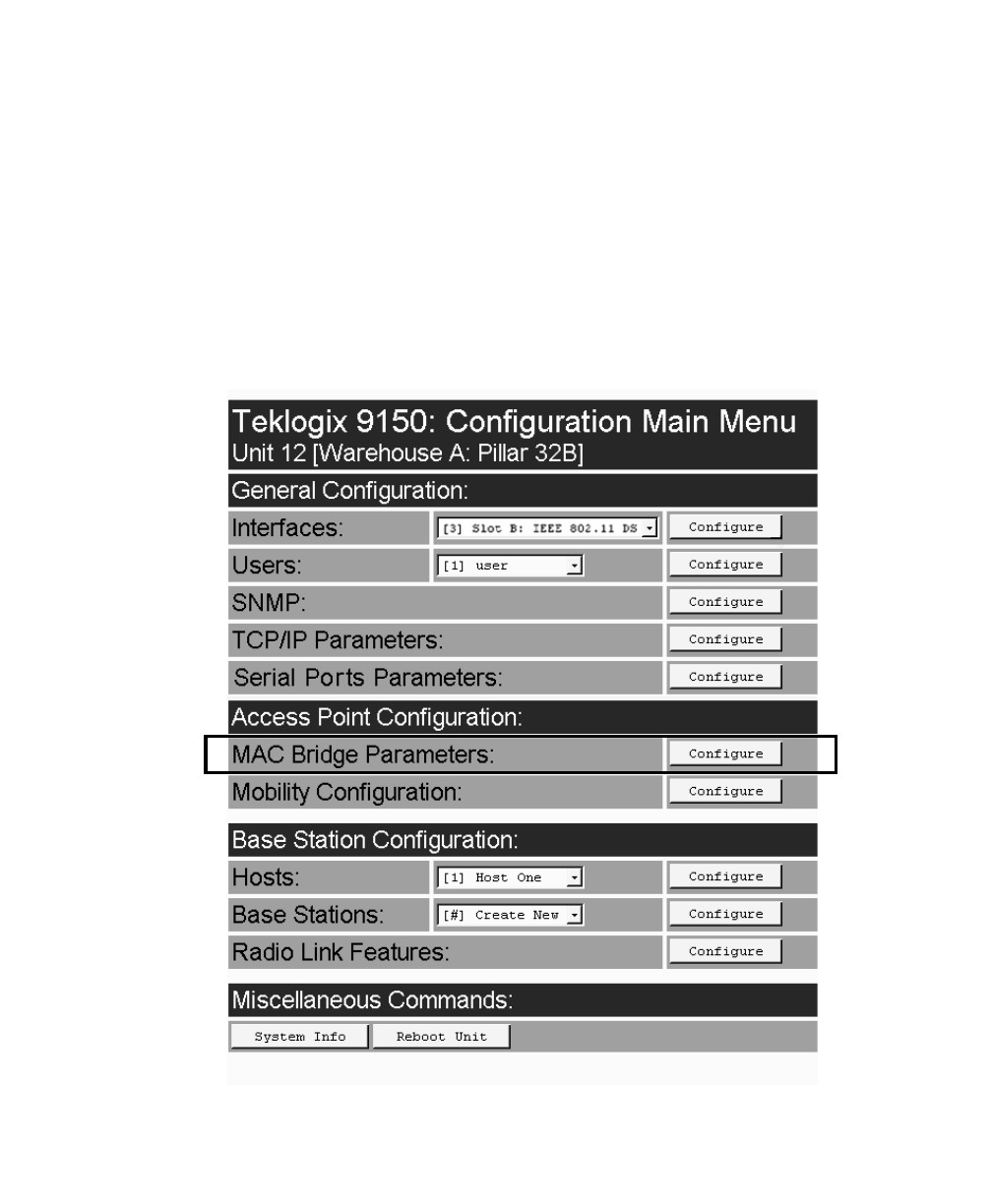
Teklogix 9150 Wireless Gateway User Manual 129
Chapter 6: Access Point Configuration
MAC Bridge Parameters
6.3 MAC Bridge Parameters
The MAC Bridge parameters consist of protocol filters which direct the 9150 to
forward or discard frames that contain a known protocol type. This enables the 9150
to be selective of what type of frames will be bridged over the radio, in order to limit
the amount of data on busy networks. Filtering frames is based on the protocol infor-
mation in the frame. This is discussed in detail in “Protocol Filters” on page 133.
The MAC Bridge Parameters page is entered from the Access Point Configuration
menu on the first page.
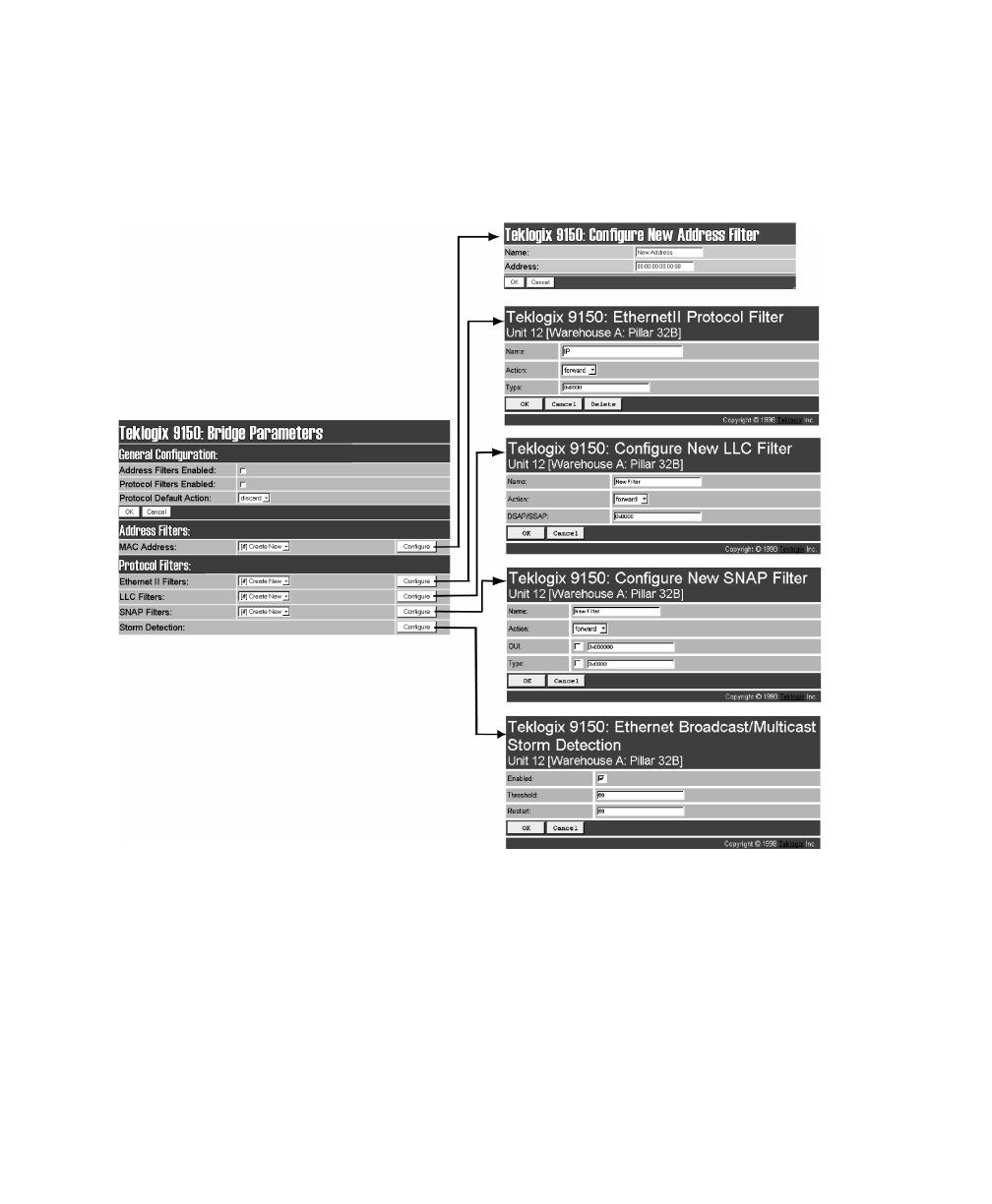
Chapter 6: Access Point Configuration
MAC Bridge Parameters
130 Teklogix 9150 Wireless Gateway User Manual
Figure 6.2 below charts the pages for the MAC bridge filters. Entering “OK” or
“Cancel” in the individual Filter pages will return you to the Bridge Parameters
page.
Figure 6.2 Overview Of MAC Bridge Configuration Menus
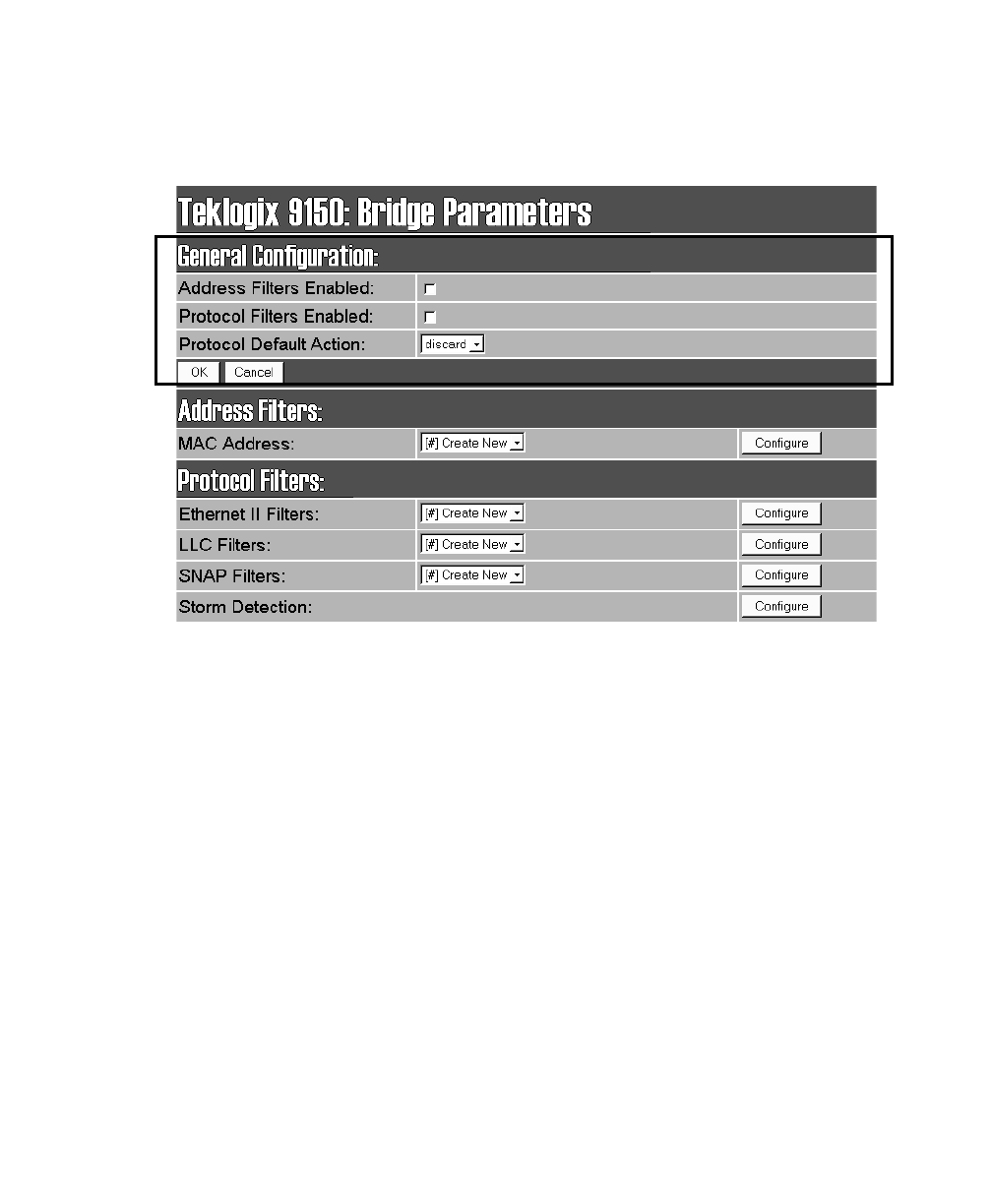
Teklogix 9150 Wireless Gateway User Manual 131
Chapter 6: Access Point Configuration
General Configuration
6.3.1 General Configuration
Address Filters Enabled
The checkbox in this parameter enables or disables the Address Filters function. If
filtering is enabled ( √ ), the 9150 can filter out frames based on destination MAC
addresses. The list of MAC addresses for filtering is set by the Address Filters option
on page 132. Frames are filtered and either forwarded or discarded, depending on
the rest of the settings in this configuration. If filtering is disabled, no filtering will
be done based on MAC addresses.
Protocol Filters Enabled
The checkbox in this parameter enables or disables the Protocol Filters function. If
filtering is enabled ( √ ), frames are filtered and either forwarded or discarded,
depending on the rest of the settings in this configuration. If filtering is disabled, no
filtering will be done based on protocol frames.
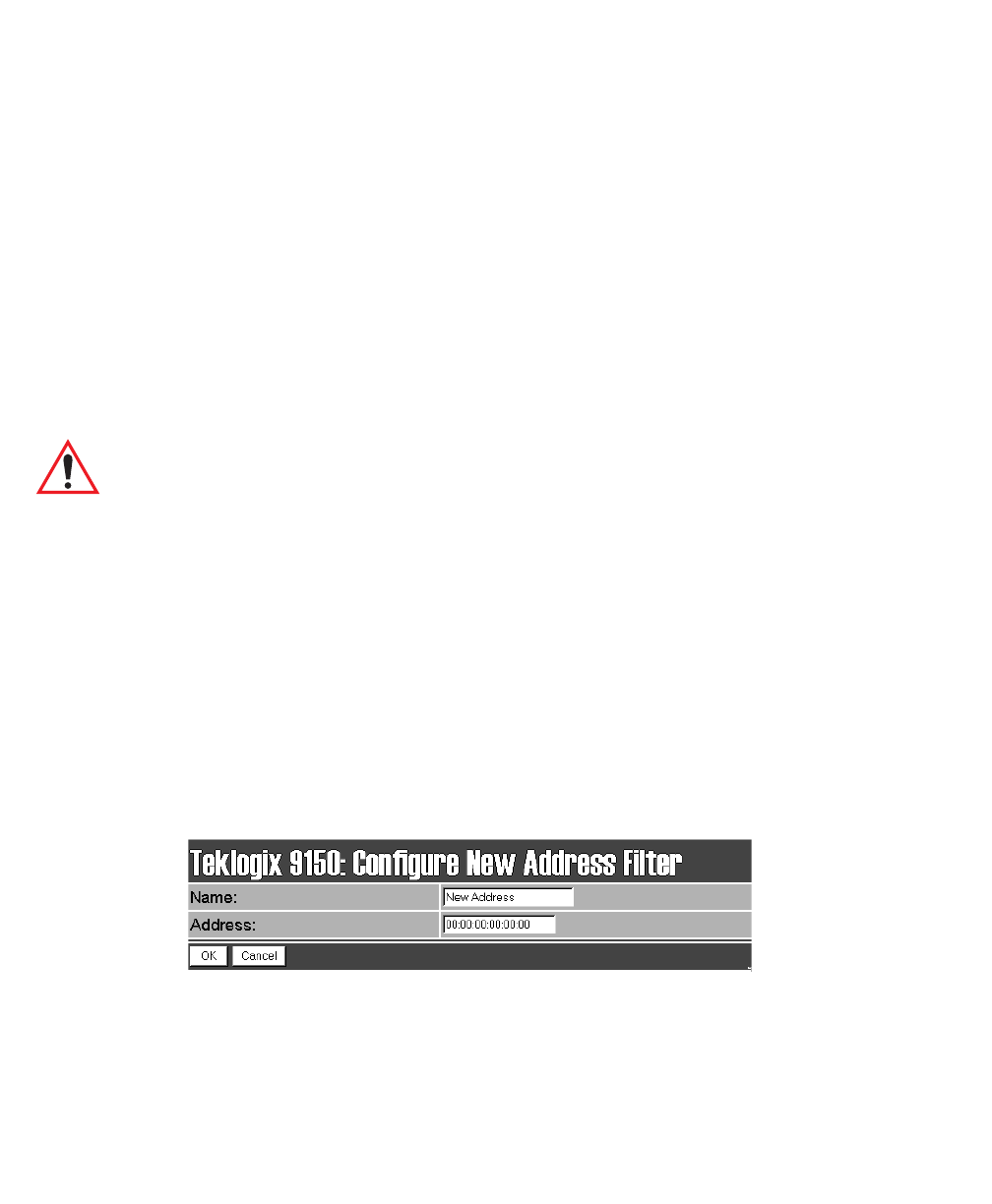
Chapter 6: Access Point Configuration
Address Filters: MAC Address
132 Teklogix 9150 Wireless Gateway User Manual
Protocol Default Action
This parameter determines which Protocol Default Action (discard or forward) will
be performed when the Protocol Filters are enabled. Each Protocol Filter (see
page 133) also has a forward/discard action associated with it. If a frame does not
match any of the filters set in the Protocol Filters configuration, then it will take the
Protocol Default Action selected in this parameter.
For example, the Protocol Default Action may be to discard all frames. If a type
field is matched in the configuration database, and the Filters action is forward, the
frame will be passed on. If the field is not matched, then the frame will be dis-
carded. Therefore if you want only IP frames forwarded, after selecting the appro-
priate IP Type in the Ethernet II Filters (see page 136) the discard setting here will
drop all frames containing other protocol types.
Important: If Protocol Filters Enabled is checked, and the Protocol Default
Action is discard, an HTTP browser will not be able to access the
9150’s configuration pages unless an ARP filter is defined to forward
ARP packets. To do this, configure Ethernet II Filters to forward pro-
tocol type 0x0806 (ARP) packets (see page 136). Alternatively, you
can create a static entry in the ARP table on the computer that is
running the browser.
6.3.2 Address Filters: MAC Address
The 9150 can use a list of destination MAC addresses to filter out frames. The MAC
addresses are those of any terminals associating with the 9150. If Address Filters on
page 131 is enabled, then any frame destined for any address in the list will be for-
warded. If an address is not on the list when Address Filters is enabled, the frame
will be discarded. Addresses are added to the filter list by entering the “Configure”
dialogue box from the Bridge Parameters menu.
Name
This is any name you wish to use to describe this terminal.
Address
This parameter provides the corresponding MAC address for the terminal.
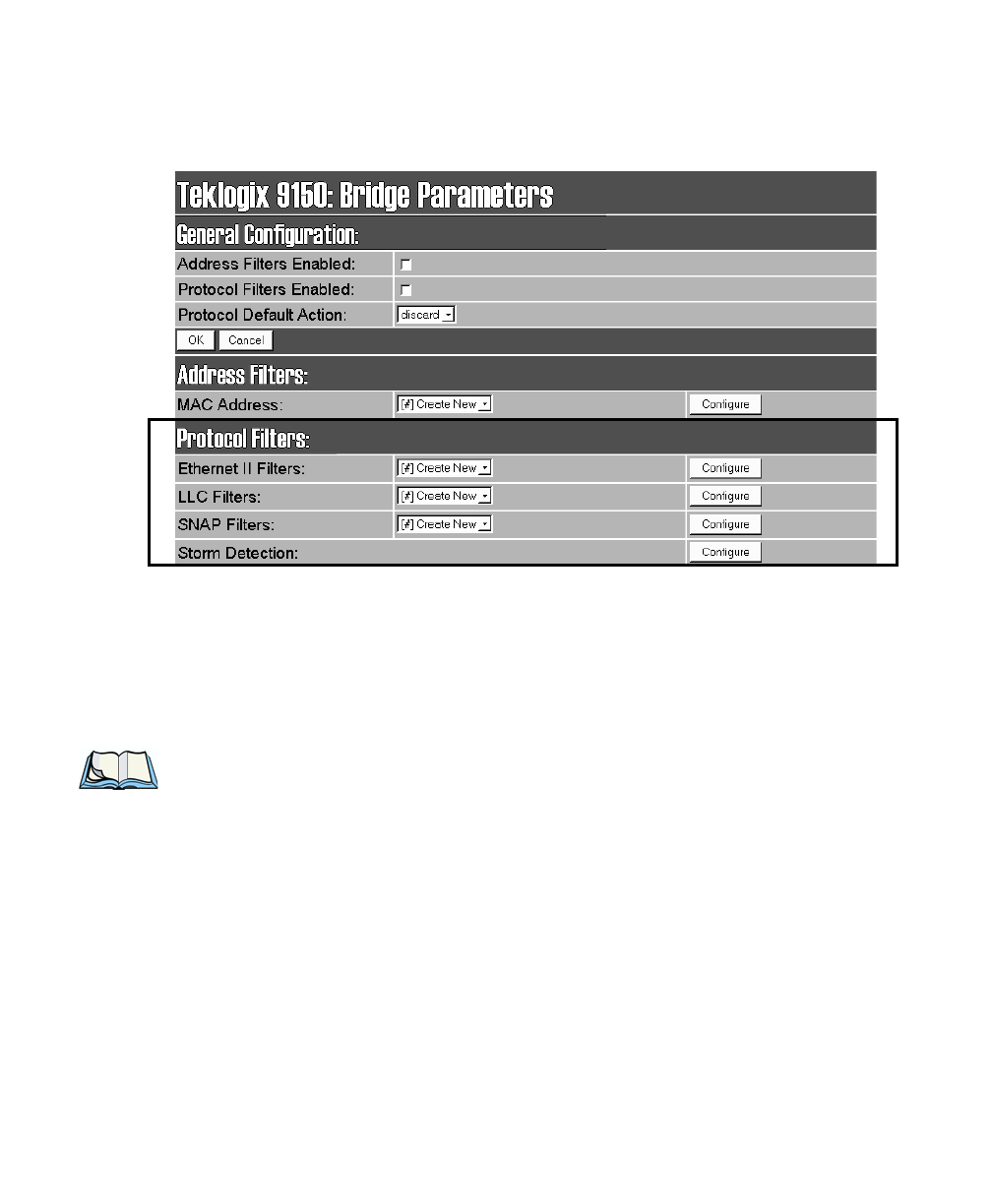
Teklogix 9150 Wireless Gateway User Manual 133
Chapter 6: Access Point Configuration
Protocol Filters
6.3.3 Protocol Filters
When the 9150 receives frames, it can forward or discard the messages by filtering
the protocol Type fields encapsulated in the frame. The filtering is done on three
types of Ethernet headers: Ethernet II, LLC and SNAP.
Figure 6.3 on page 134 illustrates the Ethernet header formats. The parameters to
configure these filters are described in the sections which follow.
Notes:
1. Although both LLC and SNAP headers are filtered on Ethernet
and Token Ring networks, Ethernet headers are not filtered on
Token Ring.
2. Throughout these menus, the values for all the protocol types are, by
convention, entered in hexadecimal, preceded by “0x”.
The fields for a basic IEEE 802.3 Ethernet frame consist of a six-byte destination
MAC address, followed by a six-byte source MAC address, and a two-byte protocol
Type. The final fields in a frame are the Data field and the FCS field (Frame Check
Sequence, or CRC). If the Type field contains a value that is greater than or equal to
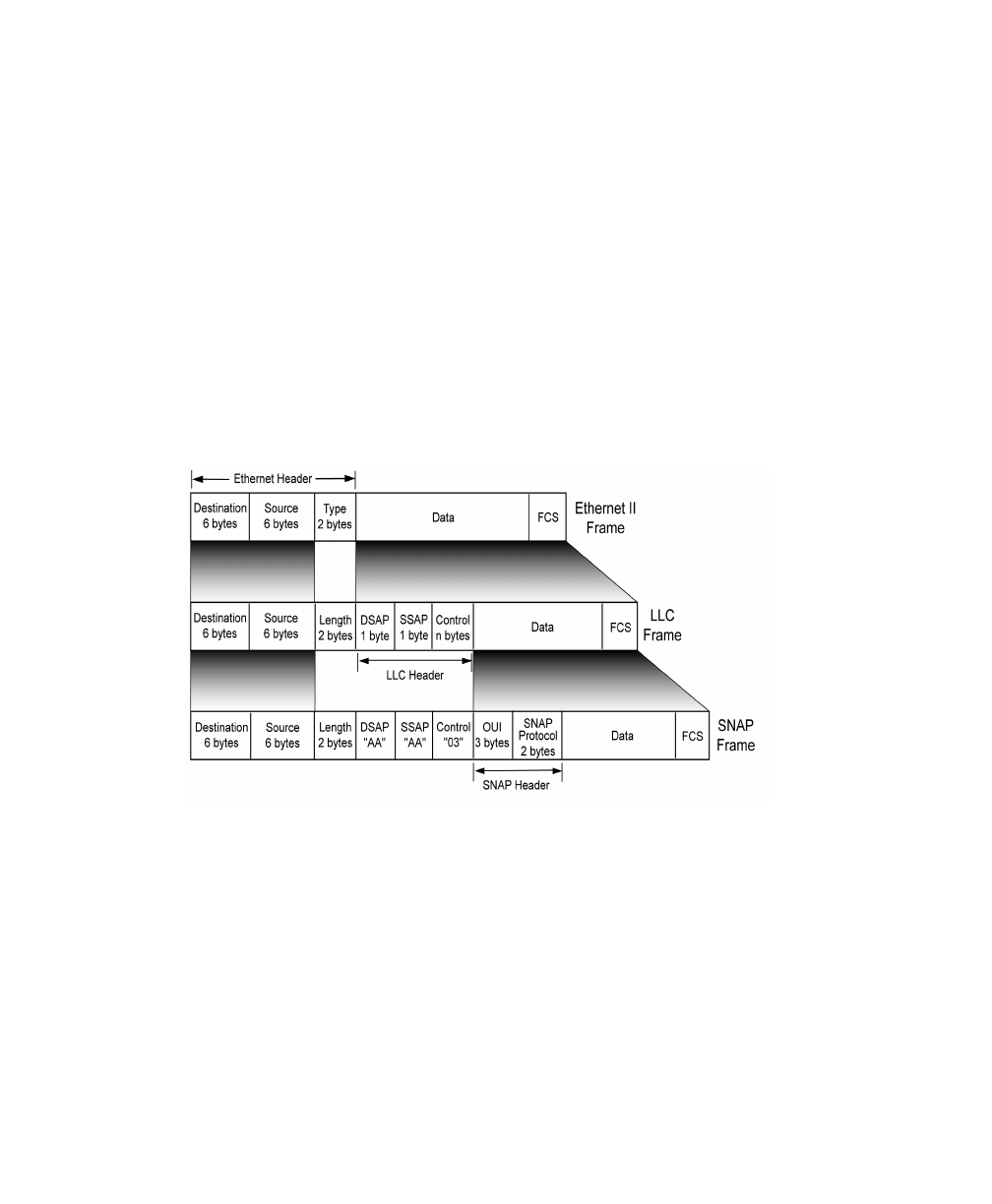
Chapter 6: Access Point Configuration
Protocol Filters
134 Teklogix 9150 Wireless Gateway User Manual
“0x0600”, it is assumed to be the protocol identifier for an Ethernet II header. This
field is used to determine which protocol is being used in the frame, and this is what
can be filtered (see “Ethernet II Filters” on page 136).
If the protocol Type is less than “0x05DC”, then the value is interpreted as a Length
field instead. It is assumed that an IEEE 802.2 Logical Link Control (LLC) header is
to follow the Length. This header consists of the Destination Service/Source Service
Access Point (DSAP/SSAP) and Control fields (see “LLC Filters” on page 137).
If the DSAP and SSAP are both “0xAA”, and the Control field has a value of
“0x03”, the LLC header will be followed by an extension which is a SNAP header.
The SNAP header includes the Organizational Unit Identifier (OUI) and the
protocol type (see “SNAP Filters” on page 138).
Figure 6.3 Ethernet Frame Types
The listboxes in the Protocol Filters option show the protocol filters already set in
the configuration database. Selecting a protocol name and then opening the “Config-
ure” dialog box gives a list of parameter settings that can be modified or deleted for
that protocol.
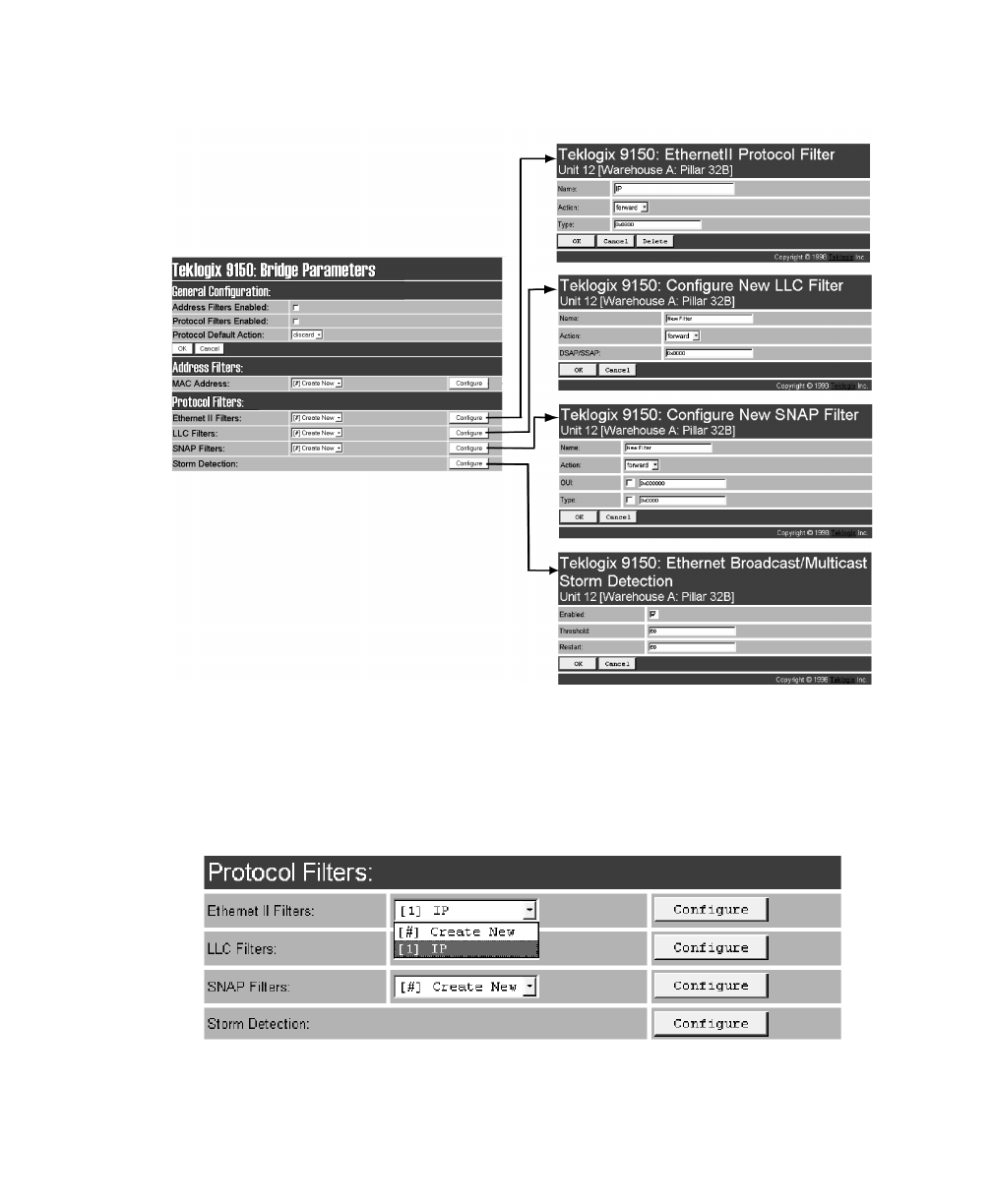
Teklogix 9150 Wireless Gateway User Manual 135
Chapter 6: Access Point Configuration
Protocol Filters
Figure 6.4 Protocol Filters Main Menu And Sub-menus
New filters can be added by selecting “[#] Create New” in the listbox before enter-
ing the “Configure” dialog box.
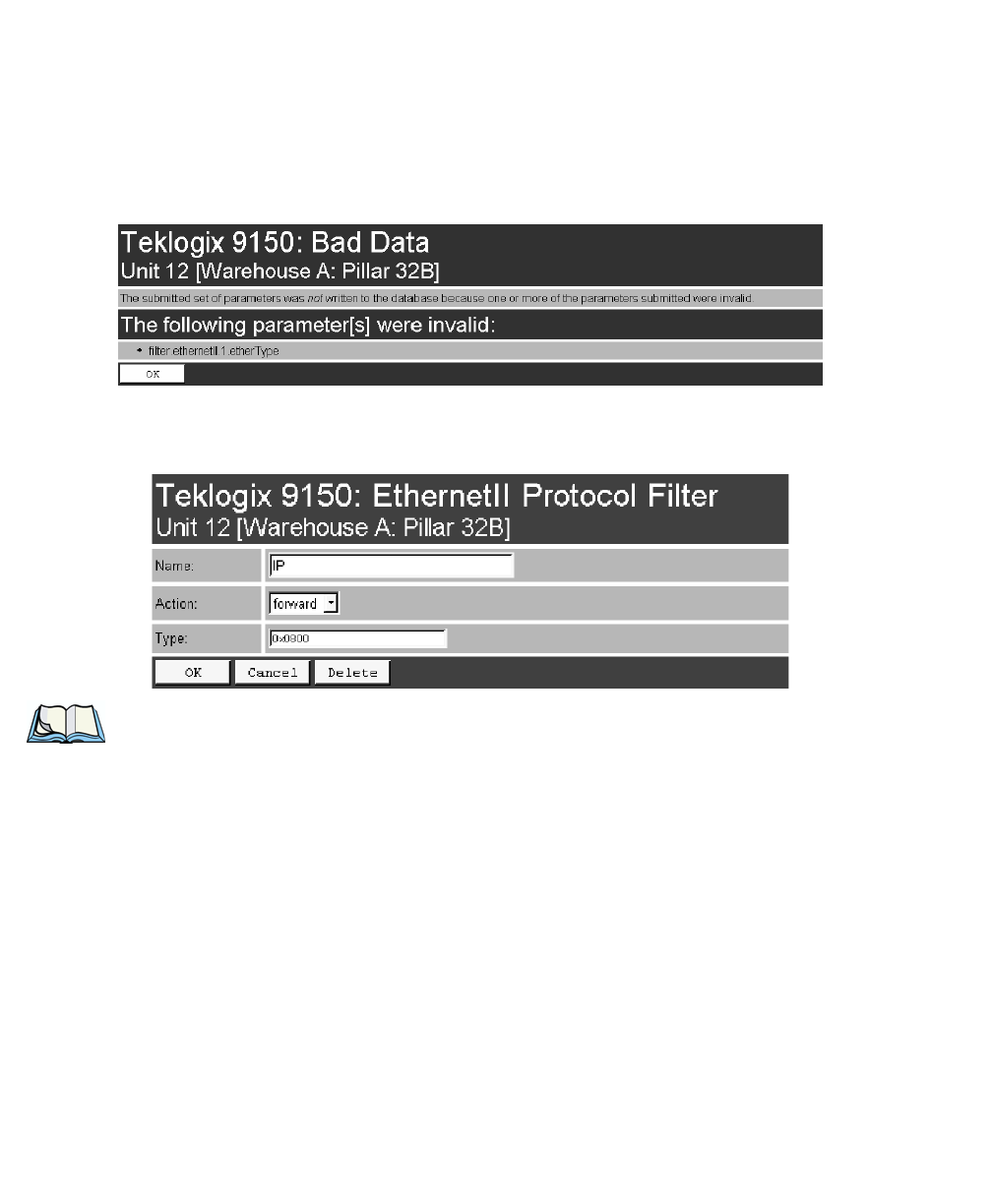
Chapter 6: Access Point Configuration
Protocol Filters
136 Teklogix 9150 Wireless Gateway User Manual
If a hexadecimal number is entered that is outside the minimum or maximum allow-
able value for these parameters, you will receive an alert that the Type value is
invalid for the specified protocol.
6.3.3.1 Ethernet II Filters
Note: This parameter is only valid for Ethernet networks. Ethernet II headers
are not filtered on Token Ring networks.
Name
This is any name you wish to use to describe this Ethernet II filter.
Action
This parameter can be set to either forward or discard frames with protocol types
that match this filter.
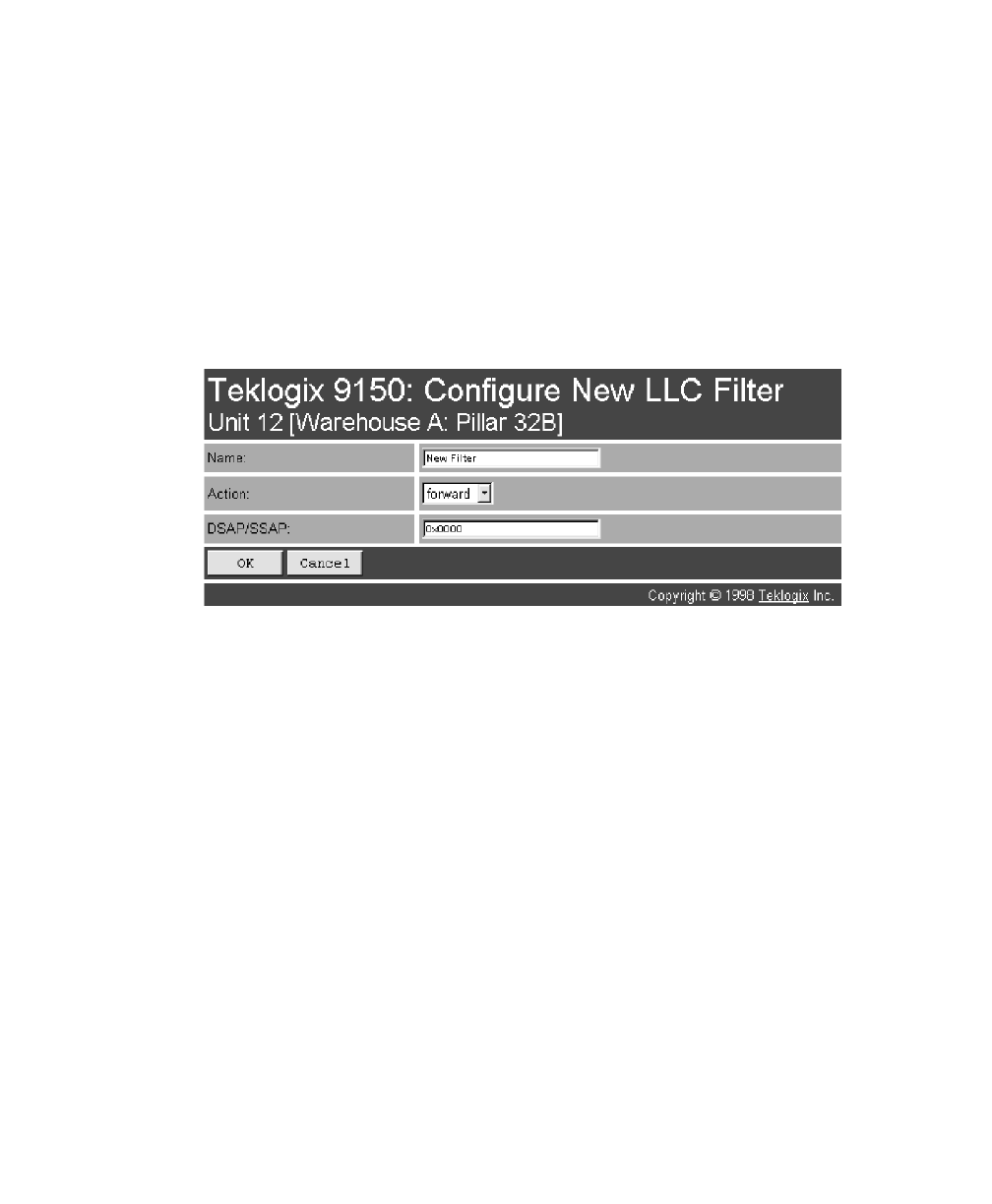
Teklogix 9150 Wireless Gateway User Manual 137
Chapter 6: Access Point Configuration
Protocol Filters
Type
The value entered in this parameter must be a four-digit hexadecimal number
ranging from 0x0600 to 0xFFFF, which represents the Ethernet II protocol type you
wish to filter. For example, if you only use TCP/IP, create two protocol filters, one to
forward IP (Type 0x0800) and the other to forward ARP (Type 0x0806). For a
listing of Ethernet II types, see “Ethernet II Types (RFC 1700)” on page B-1.
6.3.3.2 LLC Filters
Name
This is any name you wish to use to describe this LLC filter.
Action
This parameter can be set to either forward or discard frames with protocol types
that match this filter.
DSAP/SSAP
The value entered in the Destination Service/Source Service Access Point
(DSAP/SSAP) parameter must be a four-digit hexadecimal number ranging from 0
to 0xFFFF, where the first pair of digits is the DSAP and the last pair is the SSAP.
For a listing of DSAP/SSAP types, see “DSAP/SSAP Types” on page B-14.
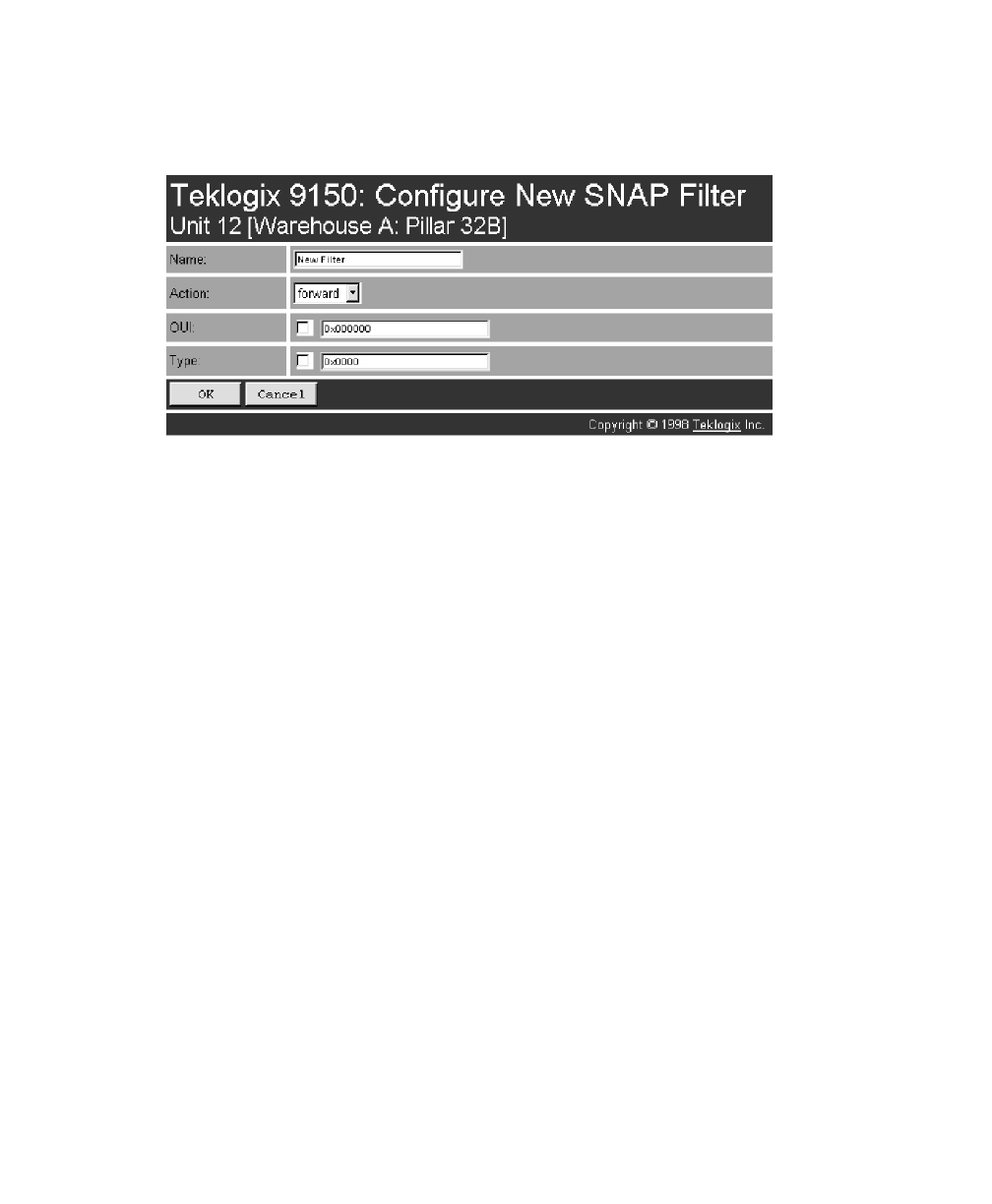
Chapter 6: Access Point Configuration
Protocol Filters
138 Teklogix 9150 Wireless Gateway User Manual
6.3.3.3 SNAP Filters
Name
This is any name you wish to use to describe this SNAP (SubNet Access Protocol)
filter.
Action
This parameter can be set to either forward or discard frames with protocol types
that match this filter.
OUI
The value entered in this parameter must be a six-digit hexadecimal number ranging
from 0 to 0xFFFFFF, which is the Organization Unique Identifier. When this
parameter is enabled ( √ ), the OUI will be filtered.
Type
The value entered in this parameter must be a four-digit hexadecimal number
ranging from 0 to 0xFFFF, which represents the SNAP type you wish to filter.
When this parameter is enabled ( √ ), this Type will be filtered.
For a short listing of OUI values, see “OUI Values” on page B-15.
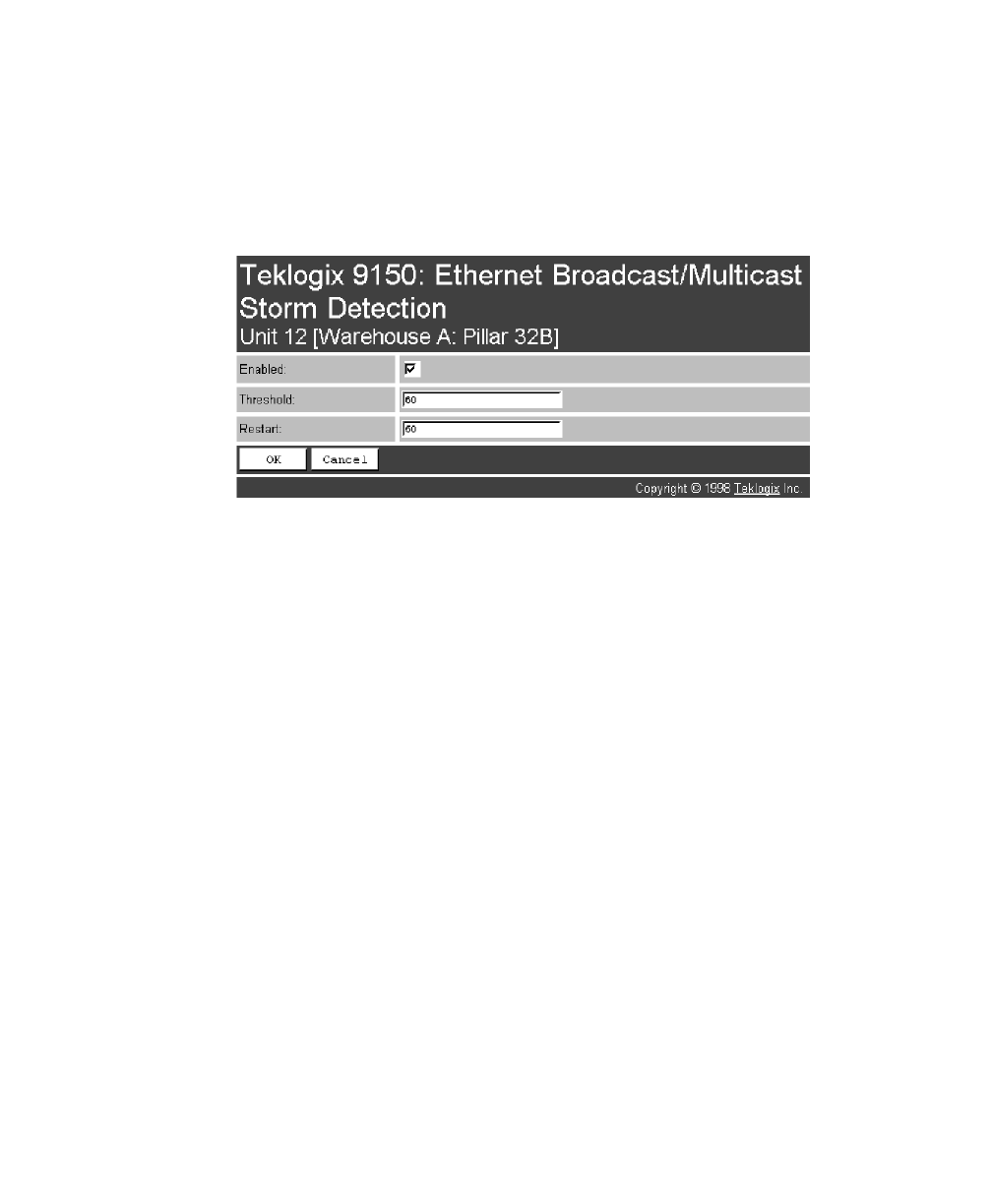
Teklogix 9150 Wireless Gateway User Manual 139
Chapter 6: Access Point Configuration
Protocol Filters
6.3.3.4 Storm Detection
This filter parameter can prevent broadcast/multicast storms from spreading
throughout the network. Network storms can burden radio traffic with unnecessary
data transmissions.
Enabled
This parameter enables ( √ ) or disables the Storm Detection filters.
Threshold
The maximum number of broadcast/multicast frames that should be received in one
second is defined in this parameter. When that threshold is exceeded, a broadcast
storm is declared. Every broadcast/multicast frame received will be discarded until it
is determined that the storm is over (see Restart, below). Setting the value for
Threshold is determined by the characteristics of your network.
Restart
The broadcast storm is determined to be over when the number of broadcast frames
received for a one second period is less than or equal to the value entered in this
parameter. Setting the value for Restart is determined by the characteristics of
your network.
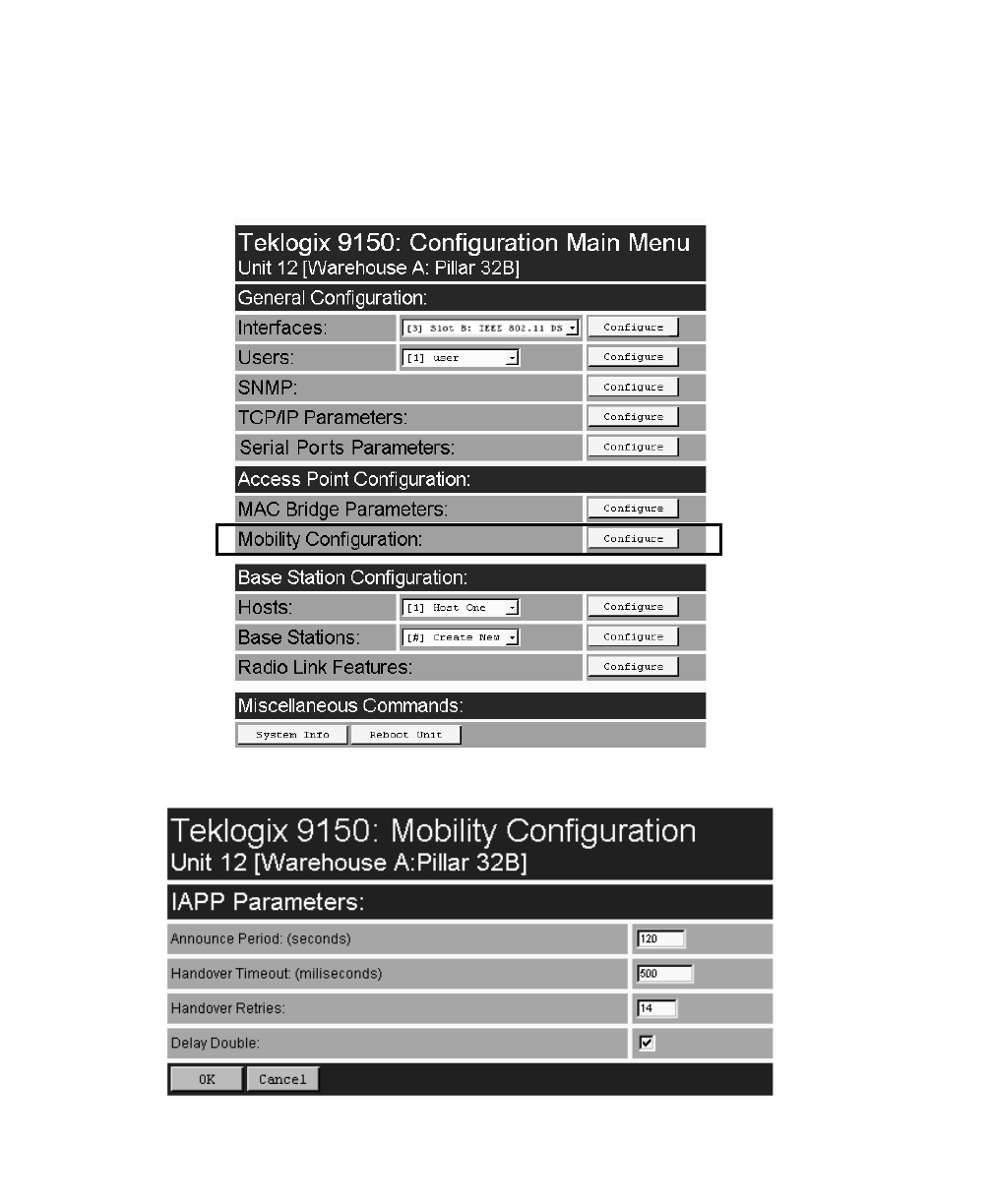
Chapter 6: Access Point Configuration
Mobility Configuration
140 Teklogix 9150 Wireless Gateway User Manual
6.4 Mobility Configuration
The Mobility Configuration page is entered from the Access Point Configuration
menu on the first page.
Going to the Mobility Configuration page opens the IAPP Parameters options.

Teklogix 9150 Wireless Gateway User Manual 141
Chapter 6: Access Point Configuration
Mobility Configuration
The Inter-Access Point Protocol (IAPP) is an extension to the IEEE 802.11 protocol.
In a multiple-9150 system, IAPP facilitates roaming of mobile stations among the
9150s, and enables communication and awareness between the 9150s. Every termi-
nal is associated with one 9150, but it can reassociate with another 9150 to maintain
uninterrupted communications. The association is “handed over” from one 9150 to
the next. The newly-associated 9150 will receive the terminal’s data frames and pass
them onto the LAN. Returning frames are no longer accepted by the original 9150,
which has disassociated from that terminal. Returning frames are now accepted by
the newly-associated 9150 and passed over the RF to the terminal. To implement
these procedures and coordinate the 9150s, IAPP specifies two message types:
Announce and Handover.
In IAPP Announce procedures, when the 9150 is initialized, it sends an IP multicast
message to inform the other 9150s in the network that it has become active. It also
informs the other 9150s of its continued operation (‘alive’ status) by periodically
multicasting the Announce beacon.
The Handover protocol is intended to inform the old 9150 that a terminal has been
associated with a new 9150, and to update the filter tables of intermediate MAC-
bridges to correctly forward frames destined for the terminal. The newly-associated
9150 sends a Handover request to the old 9150, which disassociates itself and
acknowledges the request.
Important: These parameters are set with optimum default values. Do not
adjust these values without discussing the effects with your
Teklogix representative.

Chapter 6: Access Point Configuration
IAPP Parameters
142 Teklogix 9150 Wireless Gateway User Manual
6.4.1 IAPP Parameters
Announce Period
The Announce Period parameter indicates the number of seconds between
Announce broadcasts. For further information, see “Mobility Configuration” on
page 140.
Handover Timeout
If there is no response to the Handover request by the 9150 within the time specified
in the Handover Timeout parameter, the request is retransmitted. If no response is
received after a number of retries (set in the Handover Retries parameter, below),
the 9150 will complete the reassociation procedure itself. For further information,
see “Mobility Configuration” on page 140.
Handover Retries
This parameter sets the number of times the 9150 will transmit a Handover request
to the disassociated 9150, before it completes the association transfer itself. See also
Handover Timeout, above.
Delay Double
The Delay Double parameter doubles the amount of Handover Timeout between
Handover Retries. For example, if the first retry is after 500 milliseconds, the next
Handover request is sent after 1 second, followed by a retry after 2 seconds, etc.